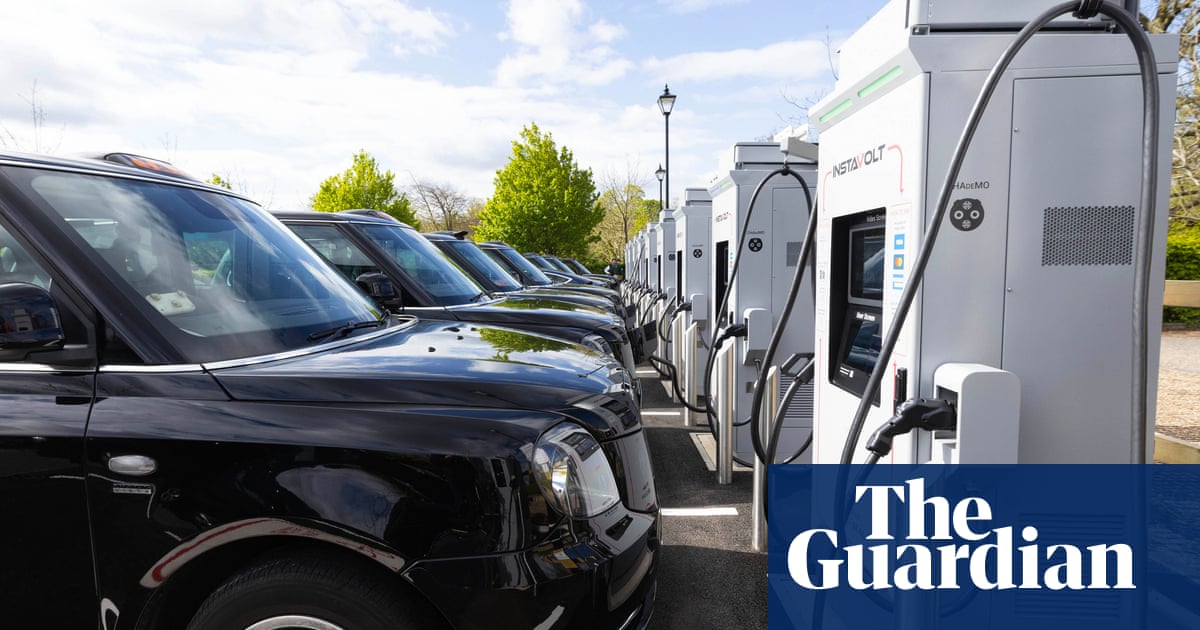Labour ministers have scrapped a promise by the previous government for a £950m fund for installing electric car chargers near motorways, instead setting aside a smaller sum mainly for on-street charging points.
The rapid charging fund (RCF) was first announced in 2020 by Rishi Sunak, then Conservative chancellor, with the aim of supporting upgrades to the grid so that more electric vehicles could be rapidly charged at the same time.
However, it wasmired in delaysamid concerns it could unfairly benefit some motorway service companies.
The Department forTransportsaid the RCF had never formally been included in budget plans, so the promise was unfunded.
The Guardian revealed in March that ministers wereconsidering directing proposed fundingaway from motorway services amid criticism of the fund’s design from industry.
The chancellor, Rachel Reeves, committed £400m over the next five years “to support the rollout of charging infrastructure” inthis month’s spending review, after announcing £200m for charging in the autumn budget. It is understood much of the spending will support on-street charge points in poorer areas, where private-sector investment haslagged behind.
However, some people in the charging industry said the government should have honoured the £950m pledge in full, even if the money was redirected towards other incentives for people to switch to EVs.
John Lewis, the chief executive of char.gy, which operates on-street chargers, welcomed the £400m pledge. However, he said: “The key question now is: couldn’t the full amount have been directed towards the EV effort – whether through the continued rollout of on-street charging or other consumer incentives – to give people greater confidence to make the switch to electric?”
The number of electric car chargers in the UK is rising rapidly, passing 80,000 in May, according to the data company Zap Map. That represented a 29% increase compared with a year earlier, while the number of rapid chargers with power above 50kW rose by a third.
Not all chargers are created equal
More and more people are buying electric cars, and are having to grapple with charging for the first time. However, not all chargers are created equal, and the profusion of units can cause confusion.
Charging speeds are measured by power output in kilowatts (kW), while battery capacity is measured in kilowatt hours (kWh). For example, a Nissan Leaf has 39kWh of battery capacity, while a Tesla Model Y has 60kWh.
Recharge times vary depending on battery size: divide the battery size by the power to get a very rough idea of how many hours it will take to charge. (E.g., a 60kWh battery at a 22kW charger would take about three hours.) The quicker the charge, the more it tends to cost.
Slow: up to 8kW
Common at homes, on-street chargers and places cars hang around like car parks or hotels. Suitable for charging overnight. Plugging in with a UK three-pin plug to the mains at home will deliver about 2.3kW – although it is not recommended.
Fast: 8kW to 49kW
Found at urban sites like supermarkets, shopping centres or car parks. Capable of charging a smaller battery in a few hours.
Rapid: 50kW to 150kW
Typically found close to big roads for journey charging, but also increasingly found in locations such as supermarkets or gyms with short dwell times. 50kW could give 80% charge in less than an hour.
Ultra-rapid: 150kW and above
Most chargers being installed at motorway services or dedicated charging hubs are now at least 150kW. Many newer cars can now handle 150kW, and several can charge at speeds of over 300kW, adding hundreds of miles of range in around 10 minutes.
Increasing the number of public chargers is seen as crucial to persuading people to switch to electric cars. However, the focus has shifted from rapid chargers, whichcan allay “range anxiety”on longer journeys, to the slower on-street chargers needed for car owners who do not have private parking spaces.
Ian Johnston, the chief executive of Osprey Charging, said: “New funding should be more effectively deployed on projects in prime locations where the grid connection costs render the site unviable – whether A roads, underserved regions or the small number of motorway locations with unviable grid – rather than gifted to all motorway sites regardless of the costs, as was envisaged under the RCF.”
Johnston also called for changes to road signage permissions to allow charge points to be easily advertised to drivers.
Quentin Willson, the founder of FairCharge, a group campaigning for cheaper charging, said the full £950m should have been spent on accelerating the switch to electric cars.
“Withholding unused RCF funds and not diverting them towards other EV charging initiatives isn’t a great look for government,” he said. “It opens them to the obvious questions about their commitment to the EV transition.”
Willson, a former presenter of Top Gear, said the government should alsocut VAT on public chargingto match the lower rates available on home electricity.
A Department for Transport spokesperson said:“The rapid charging fund was designed to support the rollout of charging infrastructure on motorways and major A roads – but the previous government did not set out detailed plans to deliver this.
“Since the fund was announced in 2020, the market has changed significantly, with the number of open-access rapid and ultra-rapid charge points within one mile of the strategic road network almost quadrupling in the last three years alone.”
